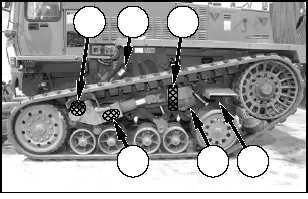Accumulator and connecting lines may be
pressurized.
Read and follow the maintenance manual and the
instructions below before working on the
accumulator and connecting lines.
Failure to follow the maintenance manual or the
instructions can cause rapid discharging of gas
or hydraulic fluids which can result in injury or
death.
1. Slowly bleed all hydraulic pressure off the
hydraulic side of the accumulators by using the
hydraulic disconnects.
2. Slowly discharge all gas pressure by opening
gas valve at one end of the accumulator until gas
begins to escape. Wait until all gas pressure is
relieved
before
proceeding
with
next
maintenance procedure.
(13) Brake accumulator, beneath cab. (14) Front cylinder
accumulator, each side of machine. (15) Middle cylinder
accumulator, each side of machine. (16) Bogie cylinder
accumulator, each side of machine. (17) Recoil accumulator,
each side of machine. (18) Kneeling accumulator, each side of
machine.
Accumulator warning labels are attached to each
accumulator on the machine.
General Hazard Information
Attach a Do Not Operate warning tag to the start
switch or controls before servicing or repairing the
machine. This tag is available from TACOM.
Know the width of your attachments so that proper
clearance can be maintained when operating near
fences, boundary obstacles, etc.
Wear a hard hat, protective glasses, and other
protective equipment as required by job conditions.
Wear eye and face protection when working with
hydraulic or air lines.
Do not wear loose clothing or jewelry that can catch
on the controls, or other parts of the machine.
Make certain that all protective guards and covers are
secured in place on the machine.
Keep the machine, especially the deck, walkways and
steps, free of foreign material; such as debris, oil, tools
and other items which are not part of the machine.
Secure all loose items such as tools and other items
which are not part of the machine.
Know the appropriate work site hand signals and who
gives them. Accept signals from one person only.
Do not smoke when servicing air conditioners or
wherever refrigerant gasses may be present. Inhaling
air-conditioner refrigerant gas through a lit cigarette or
other smoking method or inhaling fumes released from
a flame contacting air-conditioner refrigerant gas can
cause bodily harm or death.
Never put maintenance fluids into glass containers.
Drain all liquids into a suitable container. Dispose of all
liquids according to local regulations.
Use all cleaning solutions with care.
Report all needed repairs.
Do not allow unauthorized personnel on the machine.
Do not operate the engine coolant heater while
refueling the machine. Do not place any combustible
or heat sensitive material within 50.8 mm (2 in) of the
heater’s exhaust system. Routinely inspect the fuel
delivery system for leaks. Repair all leaks before
operating the heater. Operation of the heater
produces harmful vapors which represent an
asphyxiation hazard. To guard against asphyxiation:
do not operate the heater in an enclosed space;
ensure that no exhaust fumes enter the operator’s
compartment. Exhaust components can be extremely
hot. Do not touch the exhaust components until the
parts are cool.
13
14
15
16
17
18
WARNING
!
9
Safety Section
Safety
TM5-2430-200-10

